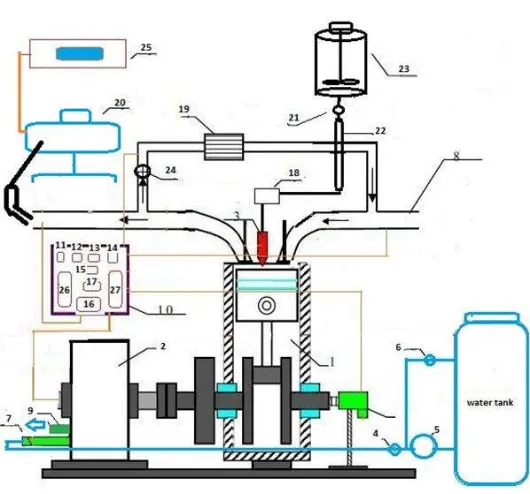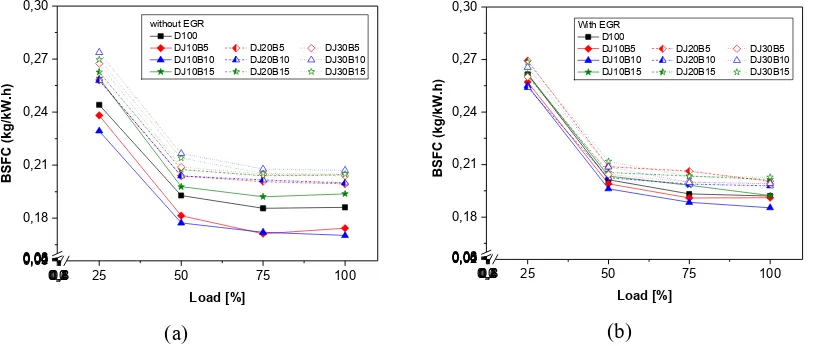Effect of butanol on fuel consumption and
smoke emission of direct injection diesel engine
fueled by jatropha oil and diesel fuel blends
with cold EGR system
Syarifudin1,*, Syaiful2, and EflitaYohana2
1
EDP Sciences, Editorial Department, 91944 Les Ulis Cedex A, France
1,2Mechanical Engineering Department, Diponegoro University, 50275 Semarang, Indonesia
Abstract.Diesel engines are widely used in industry, automotive, power generation due to better reliability and higher efficiency. However, diesel engines produce high smoke emissions. The main problem of diesel engine is actually the use of fossil fuels as a source of energy whose availability is diminishing. Therefore alternative fuels for diesel fuels such as jatropha and butanol are needed to reduce dependence on fossil fuels. In this study, the effect of butanol usage on fuel consumption and smoke emissions of direct injection diesel engine fueled by jatropha oil and diesel fuel with cold EGR system was investigated. The percentage of butanol was in the range of 5 to 15%, jatropha oil was in the range of 10 to 30% and the balance was diesel fuel. Cold EGR was varied through valve openings from 0 to 100% with 25% intervals. The experimental data shows that the BSFC value increases with increasing percentage of butanol. In addition, the use of EGR results in a higher increase of BSFC than that without EGR. While the addition of butanol into a blend of jatropha oil and diesel fuel causes a decrease in smoke emissions. The results also informed that the use of EGR in the same fuel blend led to increased smoke emissions.
1 Introduction
without sacrificing power and economic value of diesel engines, but the use of jatropha as a blend material results in higher carbon emissions compared to diesel [6].
Syaiful et al [7] in his research observed that by adding liquor alcohol (methanol) to jatropha and diesel fuel blends can reduce soot emissions, and this decrease increases with increasing percentage of alcohol in the blended. According to Imtenan S et al. [8], blending butanol on the use of jatropha-fueled diesel engines, resulting in lower carbon emissions compared to diesel fuels. In the study Fayad MA et al. [9], the active role of oxygen compounds contained in butanol as a blend of diesel fuel has an effect on increasing the oxidation concentration thereby suppressing the formation of soot. In addition, the high rate of heat propagation can decrease the size of Particulate Matter (PM). This is evidenced by Chen Guisheng et al. [10], by experimenting the addition of butanol by 20% (B20) and 30% (B30) on diesel fuel. The effect of the addition of B20 blended is slightly better than B30 in decreasing soot formation due to longer ignition time. Therefore, it can be concluded that the use of butanol and jatropha as a blended of diesel fuel with the EGR system has a positive impact on diesel engines, so research needs to be done specifically on specific fuel consumption and the resulting carbon black emissions.
[image:2.595.165.430.342.589.2]2 Research Methods
Fig. 1.Schematic of experiment.
Table 1.Properties of alkohol and diesel.
No Propertis Diesel Jatropha Butanol
1 Viscosity (at 40oC (mPa.s)) 2,0-5,0 3,23 2,63
2 Water content (%v) 0,05 3,16 34,22
3 Cetane number 48 41,8 17
4 Heating value (MJ/kg) 45,21 37,97 33,21
5 Flash point (oC) 60 198 35
6 Oxygen Content (%) - 10,9 21,69
3 Result and Discussion
3.1 Data and Analysis of Fuel Consumption Test Result (BSFC)
Figures 2 (a) and 2 (b) illustrate the effects of fuel variations on BSFC with EGR applications and without EGR. The value of BSFC decreases as the percentage of load increases. This decrease is due to an increase in cylinder wall temperature which decreases the ignition delay. So that burning increases and fuel consumption decreases [11]. The use of blended fuel produces a higher BSFC value than pure diesel. Increased percentage of jatropha and butanol cause increasing BSFC value. This increase is due to the high concentration of oxygen in butanol [12]. The increase in the value of BSFC due to the percentage of butanol also occurred in the study of Ibrahim Amr [13], and Hua Tan Yie et al. [1]. Increasing jatropha content in blended fuel also resulted in increased BSFC value. This is due to the low value of heat contained in jatropha [14]. In addition, the opening of the EGR valve also causes the value of BSFC to be increased compared without EGR. The increase of BSFC value is due to dilution effect by decreasing the concentration of oxygen into the cylinder. As observed by Donghui Qi et al. [15].
0,00,20,40,60,8 25 50 75 100 0,00
0,02 0,04 0,06 0,08 0,18 0,21 0,24 0,27 0,30
without EGR D100
DJ10B5 DJ20B5 DJ30B5 DJ10B10 DJ20B10 DJ30B10 DJ10B15 DJ20B15 DJ30B15
Load [%]
(a)
0,00,20,40,60,8 25 50 75 100 0,00
0,02 0,04 0,06 0,08 0,18 0,21 0,24 0,27 0,30
With EGR D100
DJ10B5 DJ20B5 DJ30B5 DJ10B10 DJ20B10 DJ30B10 DJ10B15 DJ20B15 DJ30B15
Load [%]
(b)
Fig. 2. Comparison of fuel consumption for various butanol concentration for different engine loads without EGR system (a) and with EGR system (b)
concentration in butanol which is more dominant than EGR. Testing with EGR on average yields a higher BSFC score than testing without EGR. In testing without EGR, the highest increase of BSFC value occurs when using DJ30B10 fuel at 50% load which is 12.33% and the highest BSFC value occurs at 0.273 kg/kW.jam fuel. While on the test with EGR application, the highest increase of BSFC occurred on DJ30B5 fuel at full load of 5.61% and the highest BSFC value occurred on DJ30B15 fuel at the low load of 0.268 kg/kW.jam.
3.2 Data and Analysis of Emissions of Soot (Opacity)
Figures 4 (a) and 4 (b) are a presentation of the effect of fuel variations on opacity with EGR applications and without EGR. Smoke opacity increases as a percentage of load increases. This is due to the reduced AFR at high loads where the amount of fuel injected is more into the combustion chamber so that much of the fuel is not burned and wasted with the exhaust gases [5]. But along with the increase in the percentage of butanol in blended fuels the smoke opacity decreases. This is evident from the diminution of particulate matter (PM) dimension in soot due to high oxygen content in blended fuel [9]. High oxygen content in alcohol (butanol) encourages the occurrence of carbon oxidation so smoke opacity becomes decreased [16]. The decrease of smoke opacity due to oxygen concentration also occurred in Huang Haozhong et al. [17], and Zerrakki M Is et al. [12]. In addition, the jatropha content in blended fuel also resulted in a decrease in smoke opacity [18]. This is due to the low aromatic compound and sulfur content in jatropha and the oxygen content present in jatropha causing a decrease in the value of smoke opacity [5].
0,00,20,40,60,8 25 50 75 100 0,0 0,2 0,4 0,6 0,8 12 15 18 21 24 27 30 33 36 without EGR D100
DJ10B5 DJ20B5 DJ30B5 DJ10B10 DJ20B10 DJ30B10 DJ10B15 DJ20B15 DJ30B15
Load [%]
(a)
0,00,20,40,60,8 25 50 75 100 0,0 0,2 0,4 0,6 0,8 12 15 18 21 24 27 30 33 36 With EGR D100
DJ10B5 DJ20B5 DJ30B5 DJ10B10 DJ20B10 DJ30B10 DJ10B15 DJ20B15 DJ30B15
Load [%]
(b)
Fig. 3. Comparison of Soot emissions (opacity) for various butanol concentration for different engine loads without EGR system (a) and with EGR system (b)
4 Conclusion
The following are the main conclusions drawn from research on specific fuel consumption and soot emissions from direct injection diesel engines with blended diesel fuel, jatropha, and butanol cold EGR:
1. Butanol and jatropha concentrations in diesel fuel cause an increase in the value of BSFC. The low heating value and high oxygen content is the cause of the increase in the value of BSFC. In addition, the EGR Application also leads to an increase in the value of BSFC.
2. Experiments with EGR result in an increase in the value of BSFC with a higher average than without EGR. The highest increase of BSFC value when testing without EGR occurs on DJ30B10 fuel at 50% load which is 12.33% and the highest BSFC value occurs at 0.273 kg/kW.jam fuel.
3. While on the test with the EGR application, the highest increase of BSFC occurred on DJ30B5 fuel at full load of 5.61% and the highest BSFC value occurred on DJ30B15 fuel at a low load of 0.268 kg/kW.jam.
4. Smoke opacity increases as a percentage of load increases. The use of butanol and Jatropha causes the smoke opacity value to be lower than D100. This is because the oxygen content in butanol and jatropha triggers the occurrence of carbon oxidation. 5. Testing of variation of fuel with EGR application also resulted in a decrease of smoke
opacity value but still higher than without EGR. In the with EGR test, the highest smoke opacity drop occurred when using DJ20B15 fuel at low loading of 25.24% and the highest smoke opacity value occurred at D100 fuel of 31.88% at full load. While using a blended fuel, the highest smoke opacity value occurs on the DJ10B5 fuel of 29.81% at full load.
6. In the EGR test, the highest smoke opacity drop occurred when using DJ20B10 fuel when the low loading was 33.46% and the highest smoke opacity value occurred at D100 fuel of 34.16% at full load. While using a blended fuel, the highest smoke opacity value occurs on the DJ10B5 fuel of 31.61% at full load.
References
1. Yie Hua Tan, Mohammad Omar Abdullah, Cirilo Nolasco, NurSyuhada Ahmad Fauzi, Georgie Wong Abdullah. Elsevier. Energy Converion and Management, 132, 54-64 (2017)
2. Heywood, John B.L. New York. Mc. Graw-Hill. Inc. (1988)
3. A. Amin, A. GadallaH, A.K. El Morsi, N.N. El-Ibiari, G.I. El-Diwani. Egyptian Journal of Petroleum.25, 509-514 (2015)
4. Chandra Pandey, V., Kripal Singh, Shankar Singh, J., Kumar, A., Singh, Bajrang., Singh, R. Renewable and Sustainable Energy Reviews, 16, 2870-2883 (2012)
5. Xue, Jinlin., Grift, Tony., Hansen, A., 2011, Renewable And Sustainable Energy Reviews, 91, 1761-1767 (2011)
6. Senthilkumar, R., Ramados, K., Manimaran, R. Global Journal of Researches In Engineering Mechanical and Mechanics Engineering, 13, 1 (2013)
7. Syaiful, and Sugeng, 2017, Nova, 51, 53-94 (2017)
8. S Imtenan, H.H. Masjuki, M. Varman, I.M. Rizwanul Fattah, H. Sajjad, M.I. Arbab. Energy Converion and Management,94, 84-94 (2015)
10. Guisheng Chen, Yinggang Shen, Quanchang Zhang, Mingfa Yao, Zunqing Zheng, Haifeng Liu, 2013.Elsevier. Energy, 54, 333-342 (2013)
11. Dwivedi, G., Jain Siddarth, Sharma, MP. Renewable and Sustainable Energy Review, 15, 4633-4641 (2011)
12. M. ZerrakiIsik, Hasan Bayindir, BahattinIscan, Dr. Huseyin Aydin. Journal of the
Energy Institute”. 90, 174-184 (2017)
13. Ibrahim Amr. Applied Thermal Engineering. 103, 651-659 (2016) 14. Karabektas, M., Ergen, G., Hosoz, M.Fuel, 04, 36-39 (2011)
15. Qi, Donghui., Leick, M., Liu, Y., Chia-Fon. Fuel, 90, 1884-1891 (2011)
16. Syaiful, Stefan, M., Bae, M.W., Kazuo, T. The Seventh international Symposium on Mechanics, Aerospace and Informatics Engineering (ISMAI), Japan, 07, 147-151 (2013)
17. Huang HaozhongQingsheng Liu, WenwenTeng, Qingxin Wang, Energy Procedia, 105, 914-920 (2017)

